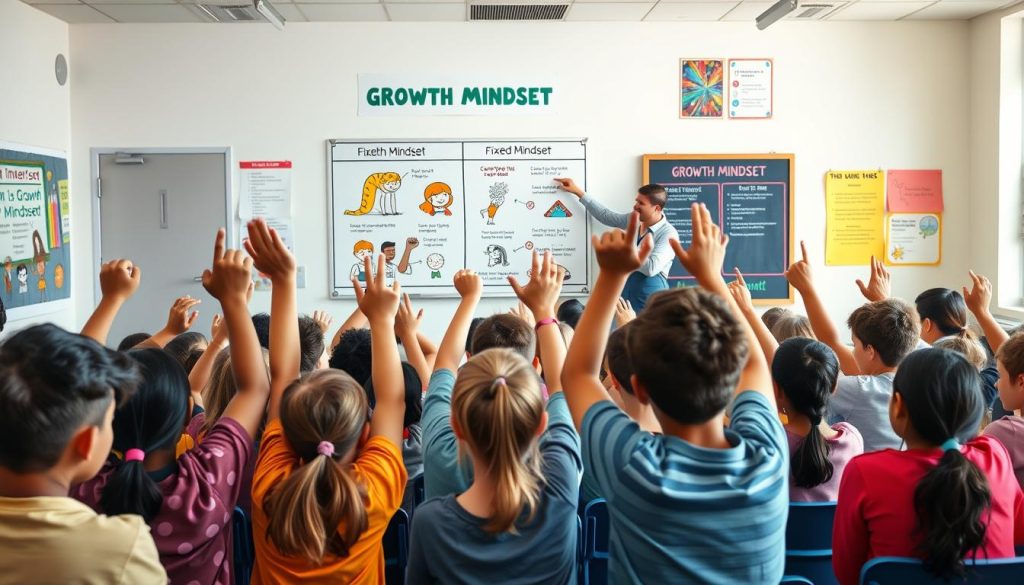Understanding Growth Mindset: The Foundation for Effective Teaching Strategies
Before diving into specific teaching strategies, it’s essential to understand what a growth mindset is and why it matters in education. Coined by Stanford psychologist Carol Dweck, a growth mindset is the belief that abilities can be developed through dedication and hard work. This contrasts with a fixed mindset, where individuals believe their basic qualities, like intelligence or talent, are fixed traits.
Research has consistently shown that students with a growth mindset achieve at higher levels than those with a fixed mindset. According to a study by Mindset Works, students who learned about growth mindset showed increased motivation and better academic performance.
As teachers develop their teacher skills around growth mindset principles, they create learning environments where:
- Students view challenges as opportunities rather than threats
- Effort is seen as a path to mastery
- Feedback becomes valuable information for improvement
- The success of others serves as inspiration rather than intimidation
Now, let’s explore eight powerful teaching strategies that can help foster this mindset in your classroom.
Teaching Strategy #1: Reframe Mistakes as Learning Opportunities
One of the most powerful teaching strategies for developing a growth mindset is reframing how we respond to mistakes in the classroom. When students see errors as opportunities rather than failures, they develop resilience and persistence—crucial teacher skills that benefit all subject areas.
How to Implement This Strategy:
- Celebrate “beautiful mistakes” that lead to deeper understanding
- Share your own learning journey and mistakes with students
- Create “mistake analysis” activities where students identify what they learned
- Use phrases like “not yet” instead of “wrong” or “incorrect”

When implementing this teaching strategy, consistency is key. Your teacher skills in responding to mistakes set the tone for how students will view their own errors. Research from Edutopia suggests that teachers who normalize mistake-making see higher levels of risk-taking and innovation in student work.
“In a growth mindset classroom, teachers value the process of learning as much as the final product, creating space for students to experiment, fail, and try again.”
Ready to transform mistakes into learning opportunities?
Discover practical classroom activities that help students embrace mistakes as part of the learning process.
Teaching Strategy #2: Use Process-Focused Praise and Feedback
The language we use when praising students significantly impacts their mindset development. Effective teaching strategies include shifting from person-focused praise (“You’re so smart!”) to process-focused feedback (“I noticed how you tried different strategies until you found one that worked”).
This shift in teacher skills requires conscious effort but yields powerful results. When we praise effort, strategies, and progress rather than innate ability, we reinforce the connection between hard work and achievement.
Examples of Process-Focused Praise:
Instead of saying:
- “You’re a natural at math!”
- “You’re so talented!”
- “You got an A without even studying!”
Try saying:
- “I noticed how you persisted with those challenging problems.”
- “The strategy you developed really paid off!”
- “Your hard work on practicing those skills made a difference.”
Developing these teacher skills takes practice. Consider creating a list of process-focused praise statements to reference until this language becomes natural. Research shows that students who receive process praise are more likely to choose challenging tasks and demonstrate greater persistence when facing difficulties.
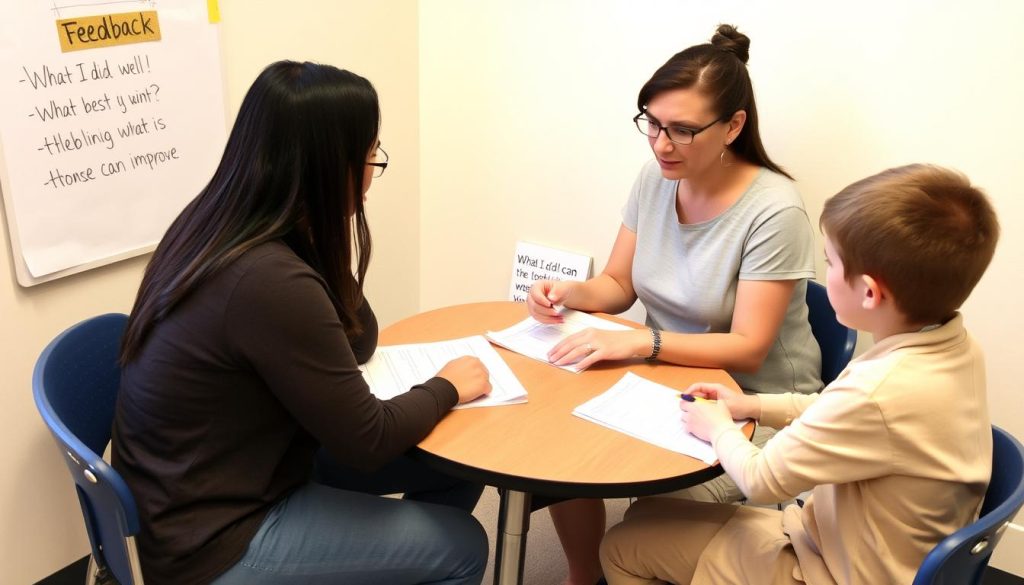
Remember that timing matters too. Immediate feedback helps students connect their efforts with outcomes, reinforcing the growth mindset principles you’re teaching.
Teaching Strategy #3: Teach the Neuroscience of Learning
One of the most impactful teaching strategies for fostering a growth mindset is helping students understand how their brains actually work. When students learn about neuroplasticity—the brain’s ability to form new connections through learning and practice—they begin to see intelligence as something that can grow rather than a fixed trait.
This teaching strategy requires developing teacher skills around explaining complex concepts in age-appropriate ways. Even young students can grasp the basic idea that the brain gets stronger with exercise, just like muscles do.
Age-Appropriate Brain Lessons:
- K-2: Use metaphors like “brain muscles” that get stronger with practice
- Grades 3-5: Introduce simple neuroscience concepts with models and visuals
- Grades 6-8: Explore how learning creates neural pathways and connections
- Grades 9-12: Dive deeper into neuroplasticity research and implications
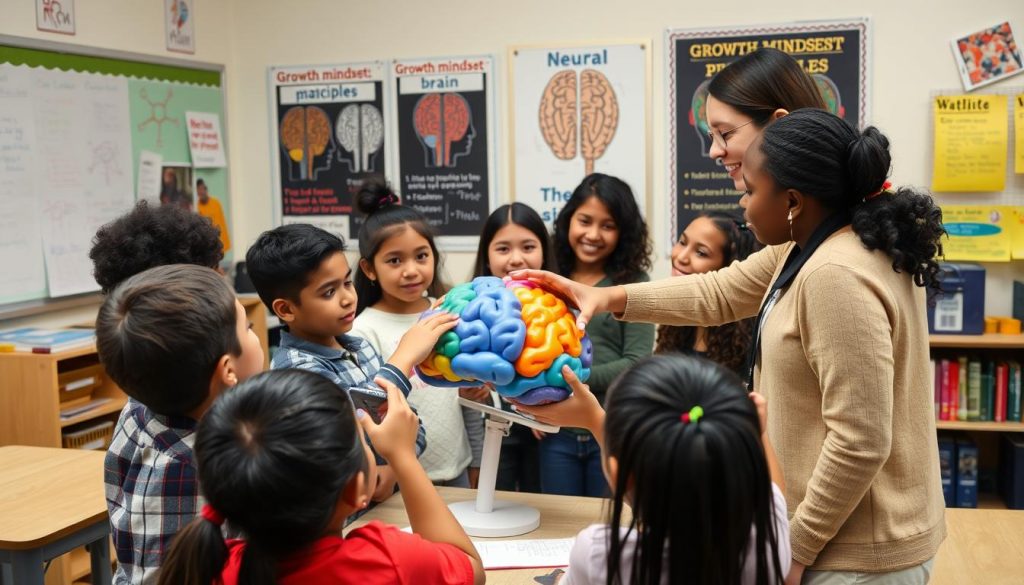
When implementing this teaching strategy, consider creating brain-themed learning stations where students can explore different aspects of how learning changes their brains. This helps develop crucial teacher skills for making abstract concepts concrete and memorable.
Teacher Tip: Share stories of people who achieved mastery through practice rather than innate talent. These narratives reinforce the neuroscience lessons and provide relatable examples of growth mindset in action.
The impact of teaching neuroscience extends beyond mindset development. Students who understand how learning works are better equipped to take ownership of their education and develop metacognitive skills that benefit them across all subject areas.
Teaching Strategy #4: Set Learning-Oriented Goals
Goal-setting is among the most versatile teaching strategies that directly supports growth mindset development. By shifting from performance goals (“Get an A on the test”) to learning goals (“Master the concept of fractions”), teachers help students focus on growth rather than validation.
Effective teacher skills in this area include guiding students to set specific, measurable, achievable, relevant, and time-bound (SMART) goals that emphasize learning processes rather than outcomes.
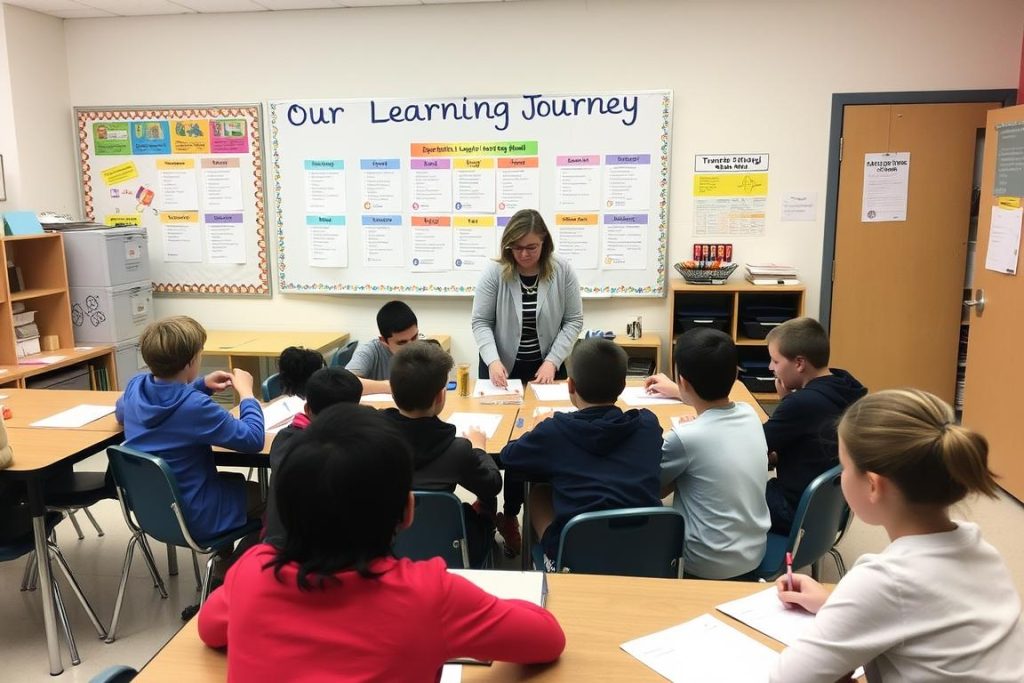
Types of Learning-Oriented Goals:
Process Goals
Focus on actions and strategies:
- “I will practice multiplication facts for 10 minutes daily”
- “I will use three new vocabulary words in my writing each week”
Learning Goals
Focus on understanding and mastery:
- “I will understand how to solve multi-step word problems”
- “I will learn to evaluate sources for research reliability”
Developing teacher skills around goal-setting includes teaching students to track their progress, reflect on their growth, and adjust their strategies when needed. This metacognitive approach reinforces the growth mindset principle that abilities develop through dedicated effort and strategic approaches.
Need help implementing goal-setting in your classroom?
Access our growth mindset course with examples for all grade levels.
When students regularly experience the satisfaction of achieving learning goals through effort and strategy, they internalize the growth mindset belief that abilities can be developed through dedication and hard work.
Teaching Strategy #5: Model Growth Mindset Language and Behaviors
One of the most powerful teaching strategies for fostering growth mindset is modeling it yourself. Students are constantly observing how teachers respond to challenges, mistakes, and learning opportunities. By deliberately demonstrating growth mindset language and behaviors, teachers develop essential teacher skills that influence classroom culture.
Growth Mindset Language to Model:
- “This is challenging, but I’m going to try different strategies until I figure it out.”
- “I made a mistake here. Let me learn from it and try a different approach.”
- “I don’t know the answer to that excellent question. Let’s find out together.”
- “I’m still developing my skills in this area, just like you are.”
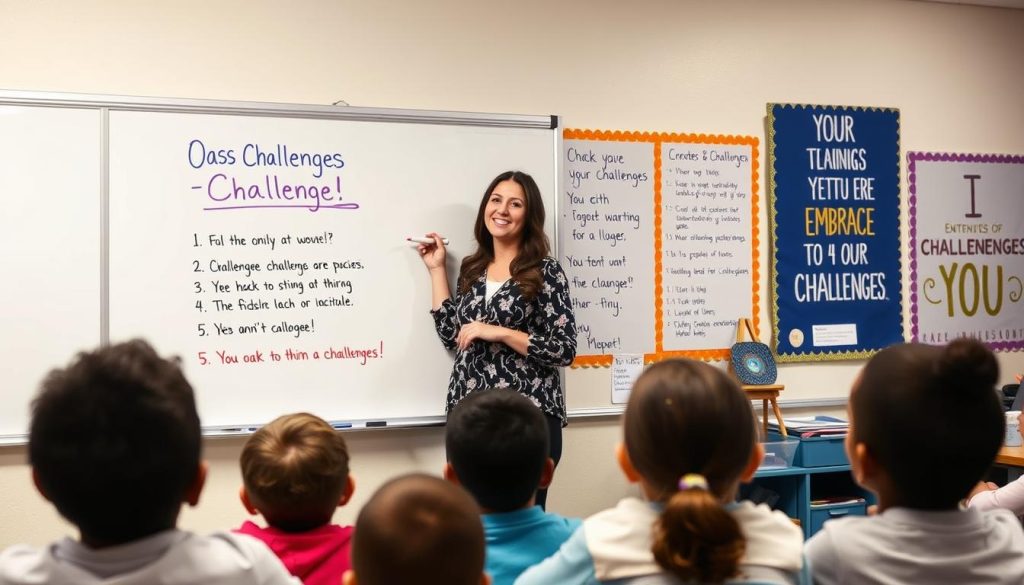
Beyond language, teachers can model growth mindset through their actions. When you tackle new teaching strategies or technologies in front of your class, narrate your learning process. Share both your struggles and your progress, demonstrating that learning is ongoing for everyone—even teachers.
“Children learn more from what you are than what you teach.”
This teaching strategy requires authentic vulnerability, an important teacher skill that creates psychological safety in the classroom. When students see that making mistakes and facing challenges is normal—even for their teacher—they become more willing to take risks in their own learning.
Consider keeping a “Teacher Learning Journal” visible in the classroom where you document your own growth mindset journey. This powerful modeling tool shows students that learning is a lifelong process.
Teaching Strategy #6: Create Challenging, Low-Stakes Learning Opportunities
Effective teaching strategies for growth mindset include designing learning experiences that stretch students’ abilities while minimizing the pressure of high-stakes assessment. These opportunities allow students to experience productive struggle—a key component of growth mindset development.
Developing teacher skills in this area means finding the sweet spot between too easy (which leads to boredom) and too difficult (which causes frustration). The goal is to create learning experiences that are challenging yet achievable with effort and perseverance.
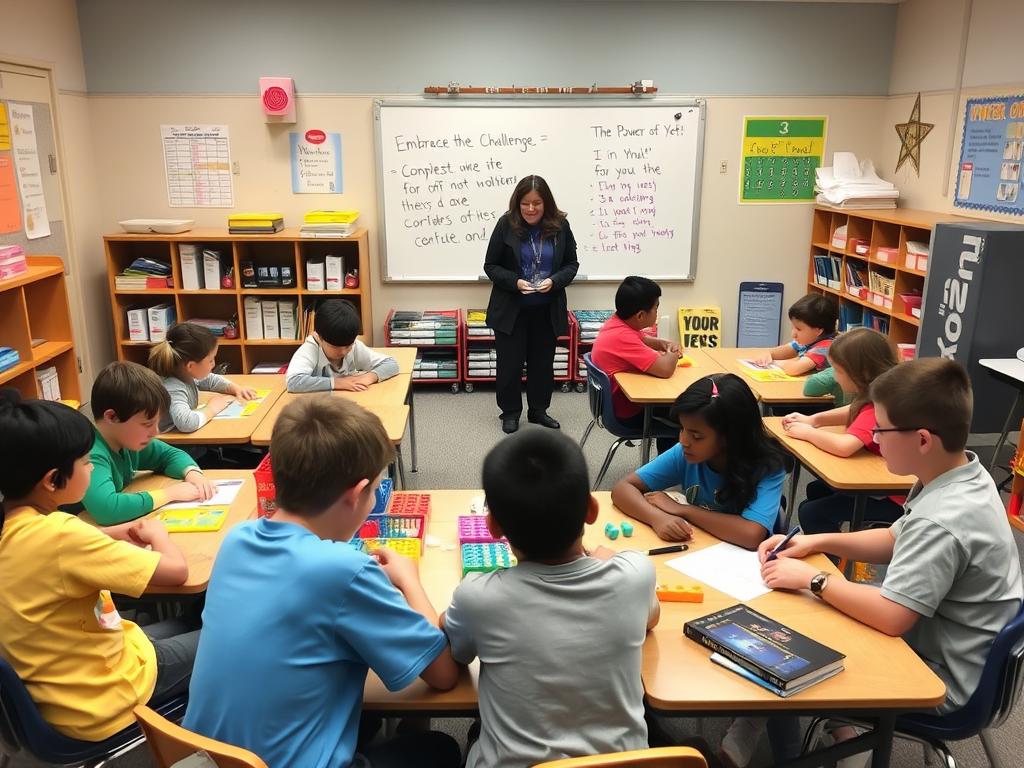
Examples of Low-Stakes Challenges:
- Problem-solving puzzles with multiple solution paths
- Design challenges that require iteration and improvement
- Socratic seminars where students grapple with complex questions
- Learning stations with tiered difficulty levels
- Peer teaching opportunities that deepen understanding
When implementing this teaching strategy, be explicit about the purpose of these challenges. Help students understand that the struggle itself is valuable—it’s where the most significant learning happens. This develops teacher skills around normalizing difficulty and reframing struggle as productive rather than problematic.
Teacher Tip: Use the phrase “This might take some time, and that’s okay” to set expectations that valuable learning isn’t always quick or easy. This simple language shift helps students develop patience with the learning process.
Remember to provide appropriate scaffolding and support during these challenges. The goal isn’t to frustrate students but to help them experience the satisfaction of persevering through difficulty to reach understanding.
Looking for challenging activities that promote growth mindset?
Explore our collection of grade-specific challenges designed to foster perseverance and problem-solving.
Teaching Strategy #7: Teach Reflection and Self-Assessment Skills
Among the most valuable teaching strategies for fostering growth mindset is teaching students how to reflect on their learning and accurately assess their own progress. These metacognitive skills help students recognize their growth over time, reinforcing the belief that abilities can develop through effort and practice.
Developing teacher skills in this area involves creating structured opportunities for reflection and teaching students how to evaluate their work against clear criteria. When students can accurately identify their strengths and areas for growth, they take greater ownership of their learning journey.
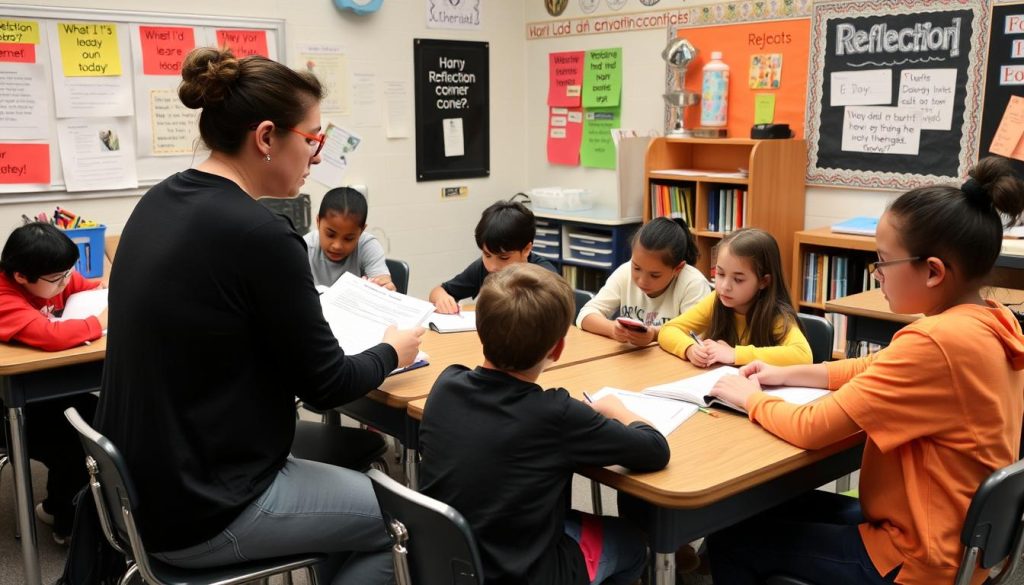
Effective Reflection Prompts:
Process Reflection
- “What strategies did I use today?”
- “How did I overcome challenges?”
- “What did I do when I got stuck?”
Progress Reflection
- “How has my understanding changed?”
- “What can I do now that I couldn’t before?”
- “What evidence shows my growth?”
This teaching strategy works best when reflection becomes a regular classroom routine rather than an occasional activity. Consider implementing daily exit tickets, weekly reflection journals, or monthly growth portfolios to help students develop the habit of reflection.
Teaching students to use specific evidence when reflecting develops critical teacher skills around assessment. Instead of vague statements like “I’m getting better at math,” guide students toward specific observations: “I can now solve two-step equations independently, which I couldn’t do last month.”
“Reflection is one of the most underused yet powerful tools for success.”
When students regularly reflect on their growth and learning processes, they develop greater self-awareness and agency—key components of a growth mindset that will serve them well beyond your classroom.
Teaching Strategy #8: Create a Classroom Culture That Celebrates Growth
The final and perhaps most comprehensive of our teaching strategies involves intentionally shaping classroom culture to celebrate growth rather than just achievement. This strategy brings together all the previous approaches into a cohesive environment where growth mindset thrives.
Developing teacher skills in culture-building means being intentional about what you recognize, reward, and make visible in your classroom. When students see that effort, improvement, and perseverance are valued as much as—or more than—natural ability or perfect performance, they’re more likely to adopt a growth mindset.
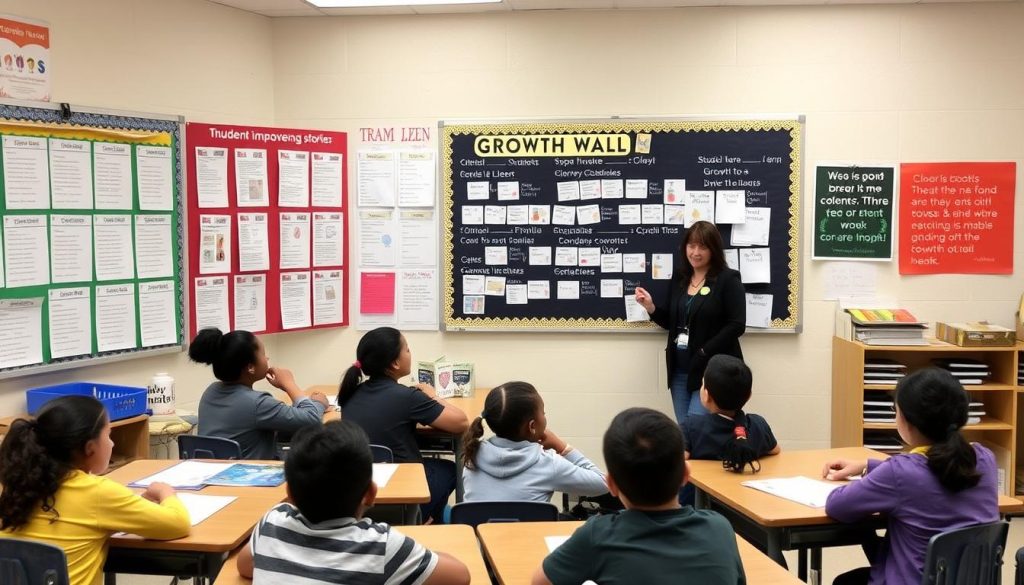
Elements of a Growth-Oriented Classroom Culture:
- Growth displays that showcase progress over time, not just final products
- Class celebrations for overcoming challenges and persisting through difficulties
- Shared language around growth, effort, and strategies
- Student leadership opportunities that allow peers to recognize each other’s growth
- Family involvement in understanding and supporting growth mindset at home
This teaching strategy requires consistent reinforcement through daily interactions and classroom systems. Consider implementing “Growth Spotlights” where you regularly highlight specific examples of students demonstrating growth mindset principles in action.
Teacher Tip: Create a “Strategy Wall” where students can post effective learning strategies they’ve discovered. This collaborative resource helps students learn from each other while reinforcing that success comes through strategic effort, not innate ability.
Remember that developing these teacher skills takes time and intentionality. Start with small changes and gradually build toward a comprehensive culture that authentically celebrates growth in all its forms.
Overcoming Challenges When Implementing Growth Mindset Teaching Strategies
While these teaching strategies are powerful, implementing them isn’t without challenges. Developing the necessary teacher skills to effectively foster growth mindset requires persistence and problem-solving—modeling the very mindset we hope to instill in our students.

Common Challenges and Solutions:
Challenge
- Students with deeply ingrained fixed mindsets
- Balancing growth praise with accurate feedback
- Finding time for reflection in busy schedules
- Maintaining consistency across all subjects
Solution
- Start small and celebrate incremental shifts in thinking
- Use the “sandwich” approach: specific praise, constructive feedback, encouragement
- Integrate brief reflection moments throughout existing routines
- Collaborate with colleagues to develop cross-curricular approaches
Remember that developing growth mindset is a journey, not a destination. Both teachers and students will have setbacks along the way. Use these moments as opportunities to model resilience and the very mindset you’re working to foster.
Need support with implementation challenges?
Join our community of educators sharing strategies and solutions for fostering growth mindset.
By anticipating challenges and developing specific teacher skills to address them, you’ll be better equipped to successfully implement these teaching strategies in your unique classroom context.
Measuring the Impact of Your Growth Mindset Teaching Strategies
How do you know if your teaching strategies are effectively fostering growth mindset? Developing teacher skills in assessment and data collection helps you track progress and make informed adjustments to your approach.
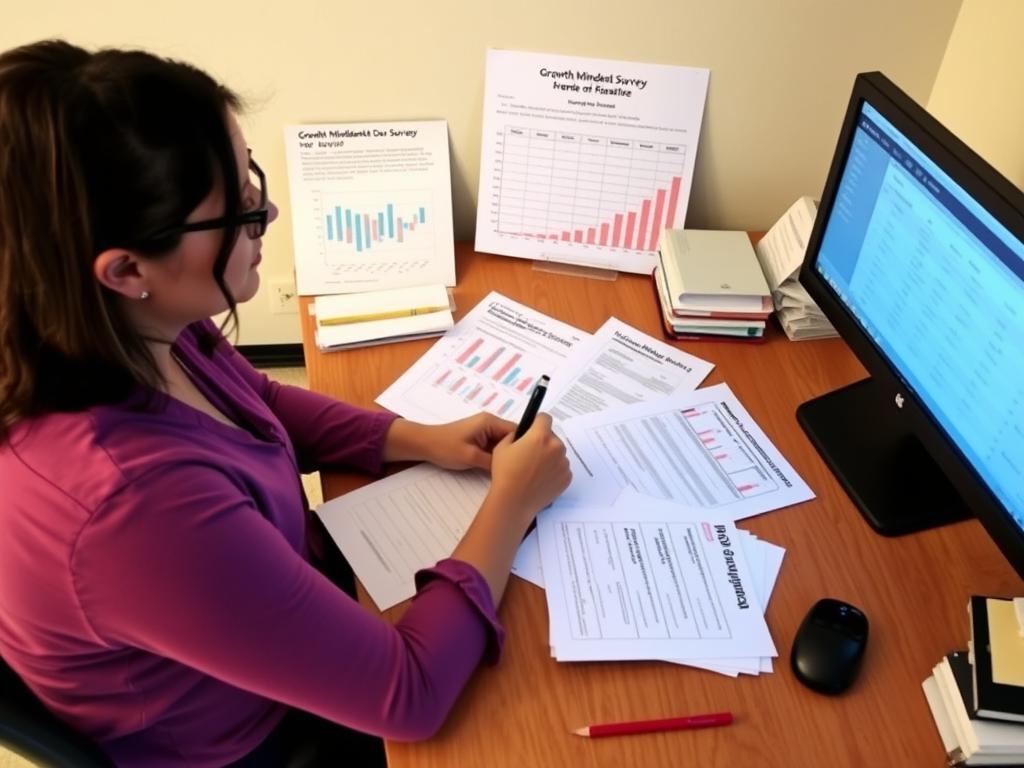
Indicators of Growth Mindset Development:
- Language shifts in how students talk about challenges and abilities
- Behavioral changes in persistence, risk-taking, and response to feedback
- Academic resilience when facing difficult material
- Self-reflection quality in student journals and discussions
- Peer interactions that demonstrate support for effort and growth
Consider using both qualitative and quantitative measures to track progress. Simple surveys, observation checklists, and student self-assessments can provide valuable data about how your teaching strategies are impacting mindset development.
Teacher Tip: Create a simple “Mindset Moments” journal where you record specific instances of students demonstrating growth mindset. These anecdotal notes provide powerful evidence of progress and can be shared during parent conferences.
Remember that mindset changes take time. Look for small shifts and celebrate them as evidence that your teaching strategies and teacher skills are making a difference. The goal isn’t perfection but progress toward a classroom culture where growth mindset thrives.
Conclusion: The Lasting Impact of Growth Mindset Teaching Strategies
Implementing these eight teaching strategies for fostering growth mindset requires dedication and the development of specific teacher skills, but the impact extends far beyond academic achievement. When students internalize growth mindset principles, they develop resilience, agency, and a love of learning that serves them throughout their lives.
As you incorporate these teaching strategies into your classroom practice, remember that you’re not just teaching content—you’re shaping how students view themselves as learners. This may be the most important work we do as educators.
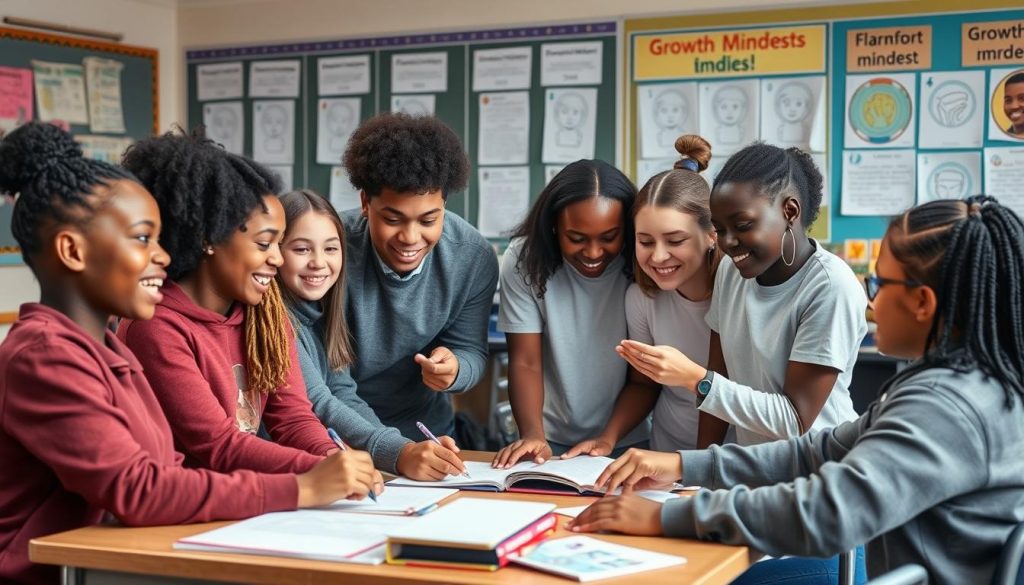
Start with one strategy that resonates with you and gradually incorporate others as your teacher skills and confidence grow. Like our students, we develop our abilities through practice, reflection, and perseverance.
Ready to transform your classroom with growth mindset?
Access our growth mindset toolkit with lesson plans, activities, and assessment tools designed for K-12 classrooms.
By consistently applying these teaching strategies, you create a classroom where challenges are embraced, effort is valued, and every student believes in their capacity to grow and learn. That’s a legacy that extends far beyond any single lesson or school year—it’s a gift that transforms lives.

